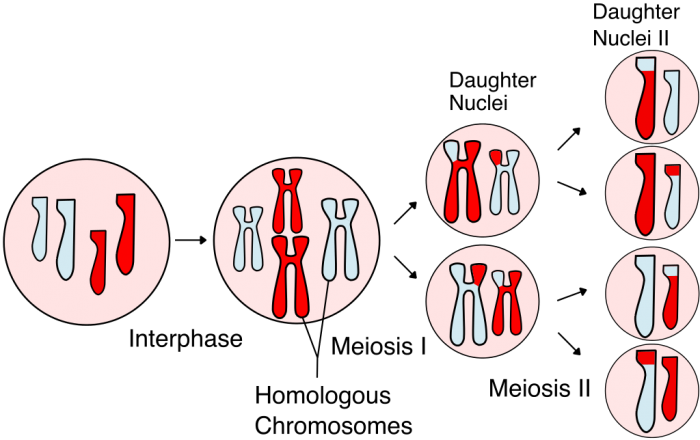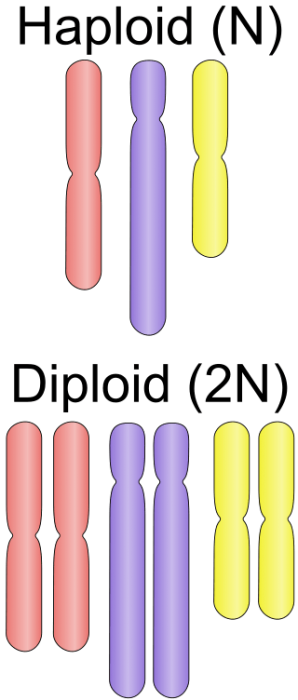
The human body needs to create new cells to replace old, worn out ones. Mitosis is the process that creates new daughter cells from the original parent cells, while meiosis is a similar process that creates just one type of cell – sex cells, or gametes.
Meiosis creates daughter cells that possess half as many chromosomes as the parent cell, and meiosis proceeds through four different phases, just like mitosis does: prophase, metaphase, anaphase, and telophase. However, unlike mitosis, meiosis goes through two round of cellular division, so there is prophase I and prophase II, metaphase I and metaphase II, etc. What happens during prophase I of meiosis?
What Happens During Prophase I?
By the time prophase I of meiosis begins, the chromosomes within the cell have duplicated and prepared for cellular division. This means that during prophase I, the chromosomes condense, becoming thicker and shorter. This makes the chromosomes visible under a light microscope. The nuclear envelope, the structure that surrounds the nucleus, breaks up, vanishing. The nucleolus, the smaller organelle within the nucleus, disappears as well. The spindle apparatus is created by long spindle fibers that extend from the two centrosomes within the cell. The spindle fibers eventually extend all the way, moving the centrosomes to opposing ends of the cell, the poles.
Each of the chromosomes found within the cell at this point are made out of two sister chromatids, and these chromatids have genetic information that is identical. Throughout most of the meiosis process, ending in metaphase II, the sister chromatids stay attached to one another, bound at the centromere. During prophase I, the two members of each homolog pair in a sex cell become linked to one another along the entire length of the chromosome. This process of association is referred to as “synapsing” and through this process, the homolog pairs form a larger structure referred to as a “tetrad”.
During synapsis, the two chromosomes of the respective homolog pairs exchange chunks of their DNA strands/swap parts of their genome. Another way to think about this is imagining the two chromosomes of each homolog pair oriented parallel to the other chromosome pair, and bits of the genetic code being pulled out one chromosome and stitched into the respective part of the other chromosome. This is referred to as crossing over. The combinations of genes in the chromosomes are changed due to this process, and the areas where crossing over occurs is essentially random. After crossing over occurs, the cell proceeds into metaphase I.
The Complete Meiosis Process

Photo: By Rdbickel – Own work, CC BY-SA 4.0, https://commons.wikimedia.org/w/index.php?curid=49599354
While prophase, as described above, is the initial phase in both rounds of cellular division, prophase is just one part of a larger, complex process that creates gametes/sex cells. The other phases of meiosis – metaphase, anaphase, and telophase – are just as important to the creation of gametes as prophase. Let’s examine the other phases of meiosis I and meiosis II to understand what prophase sets up the cell for.
Meiosis I
Prophase I
As a brief recap of prophase I, the chromosomes condense, becoming thicker and shorter as a result. The nuclear envelope vanishes, along with the nucleolus. The spindle apparatus appears and pushes the centrosomes to opposite poles of the cell. Crossing over happens during this phase as well.
Metaphase I
After crossing over happens and the chromosomes have exchanged portions of their DNA, the spindle apparatus (also called the mitotic spindle) starts to capture the chromosomes and maneuver the chromosomes towards the center of the cell, resting them in an area called the metaphase plate. While the meiosis process repositions the chromosomes on the metaphase plate, during meiosis anaphase I the chromosomes are linked to microtubules from just one end of the mitotic spindle. Half of the chromosomes are linked to microtubules from one pole, so this means that individual chromosomes aren’t readied for separation, homologous pairs are. The homologous chromosomes that lie on the metaphase plate are randomly oriented.
Anaphase I
During anaphase one of meiosis I, the homologs which lined up on the metaphase plate during metaphase are pulled on by spindle fibers. Spindle fibers are part of the mitotic spindle, and they pull the homologs to the opposite poles of the cell. The sister chromatids stay together during anaphase one, they aren’t separated. Since the chromatids aren’t separated they stay paired together into the next phase, telophase I.
Telophase I
Telophase of meiosis one sees the chromosomes which were pulled apart during the previous phase complete their journey to the opposite poles of the cell. The chromosomes may be de-condensed during telophase, depending on the type of cell. Furthermore, some organisms will reform the nuclear membrane during telophase while other organisms won’t. Because the gametes will go through another round of meiosis in order to create the four daughter cells, the reformation of the nuclear membrane at this juncture isn’t necessary. Cytokinesis is a process that is responsible for dividing one cell into two, pinching the cell in the middle until it is divided into two different cells. Cytokinesis starts in telophase, and when cytokinesis is complete two haploid cells will have been created.
Meiosis Two

Shows meiosis II phases in addition to meiosis I phases. Photo: By Ehamberg – Own work, CC BY-SA 3.0, https://commons.wikimedia.org/w/index.php?curid=10293056
Upon the completion of telophase 1, the cells enter interphase, the period of time in-between the two cycles of division where the cell readies itself to be divided a second time. It’s important to note that the DNA of the cell remains uncopied at the end of meiosis one and the beginning of meiosis two. Meiosis two is simpler and shorter when compared to the processes of meiosis one. Meiosis two can be thought of as mitosis for the two haploid cells created during the first round of cellular division. These haploid cells start the second round of the division with just a single chromosome, thanks to the events of meiosis one. Two sister chromatids comprise the chromosomes within the haploid cells. The rest of the meiosis process will have the sister chromatids separate, and the final result will be haploid cells with non-duplicate chromosomes.
Meiosis two begins with prophase two, where the chromosomes condense, much as they did in meiosis one. The nuclear envelope also unravels here if it is necessary. The mitotic spindle is formed, and in conjunction with this, the centrosomes migrate to the far poles of the cell. The mitotic spindle is full of microtubules which link the centrosomes to the chromosomes. During metaphase, the mitotic spindle and microtubules will move the chromatids into place on the metaphase plate. During anaphase, the cell readies itself to divide thanks to cytokinesis, and in preparation for this step the sister chromatids are split apart from one another and pulled towards opposite ends of the cell. In telophase, cytokinesis finishes as the nuclear membranes reform and the chromosomes continue their development. The end result is four daughter cells coming from two cells, with each of the cells having a single chromatid.
Ensuring Genetic Diversity

Difference between haploid and diploid chromosomes. Photo: By Ehamberg – Own work, CC BY-SA 3.0, https://commons.wikimedia.org/w/index.php?curid=10293056
The crossing over that occurs in prophase of meiosis one, as well as the random orientation of the homolog pairs on the metaphase plate in metaphase one, serves to diversify the genetic code of the gametes. The random orientation of the homolog pairs in metaphase alone produces about 8 million different possible combinations for the gametes, and when this is combined with crossing over the number of different gametes that can be created is functionally infinite.
Differences Between Meiosis And Mitosis
Despite sharing similarities, meiosis and mitosis are different from one another in notable ways. One of the ways that’s mitosis and meiosis differ is that in meiosis tetrads or paired chromosomes line up on the metaphase plate instead of the single chromosomes, which lineup on the plate in mitosis. The chromatids in the mitosis are capable of extending freely when they lie on the metaphase plate within the mitotic spindle, yet in meiosis, their orientation is controlled by the mitotic spindle.
The mitotic spindle is responsible for moving them, not merely orienting the chromosome pairs but dragging them towards the poles of the cell when division occurs. Finally, the chromosomes found in meiosis are dissimilar because of the genetic exchange that happens during crossing over, while during mitosis the chromosomes are genetically identical.








